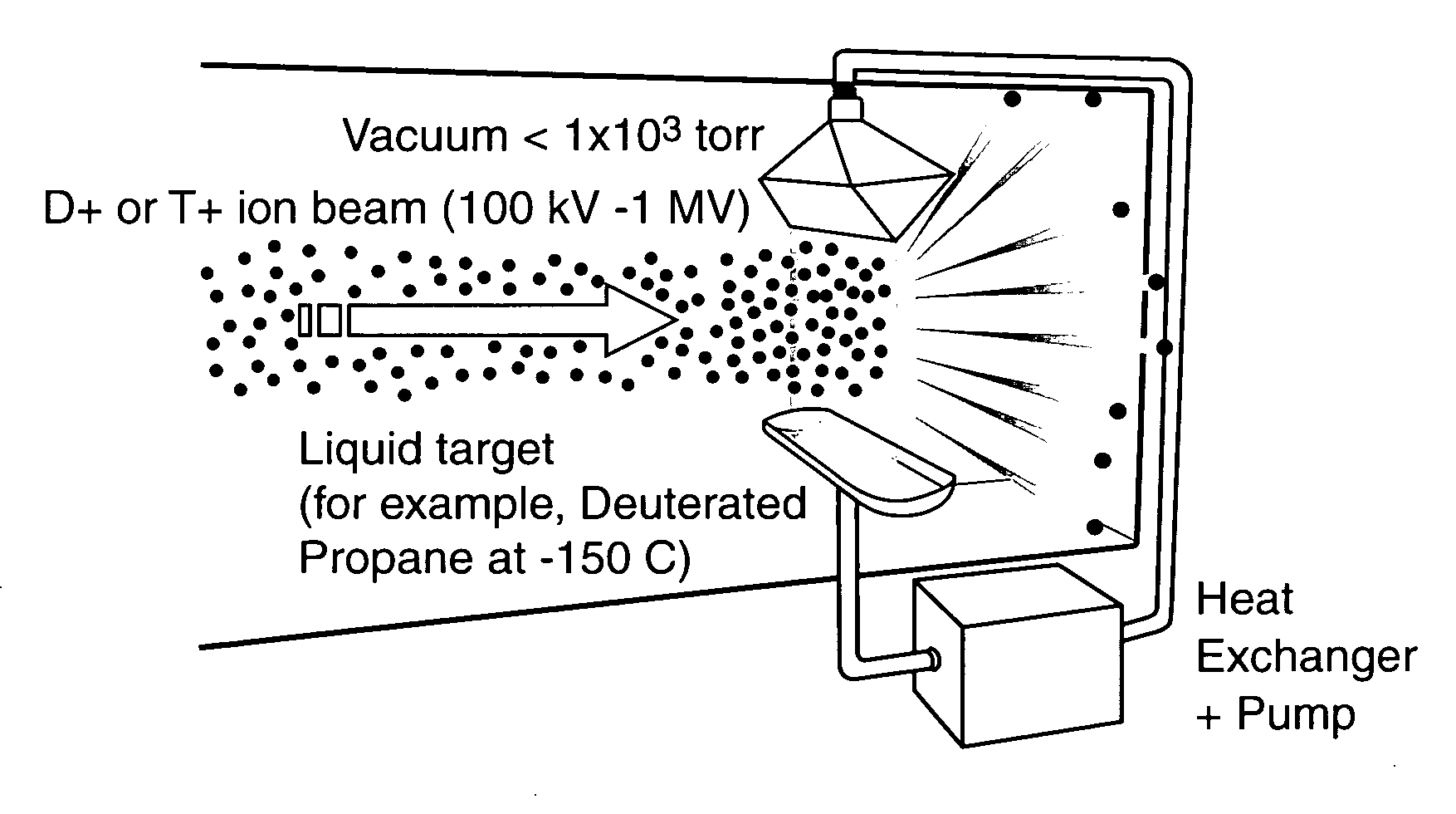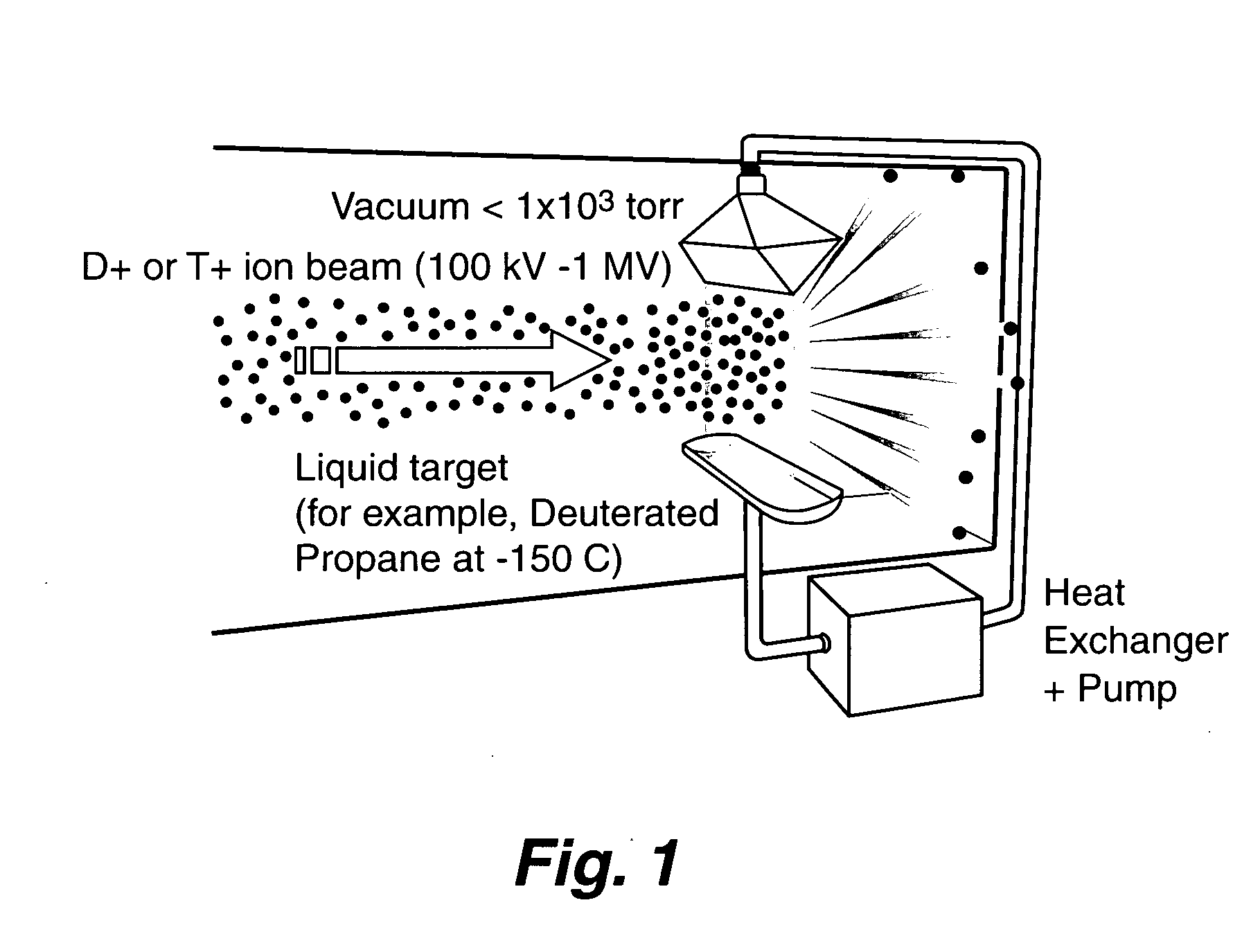[0011]The invention is a
neutron generator, which is designed to overcome many of the limitations of traditional beam-target neutron generators by utilizing a liquid target
neutron source, as depicted in FIG. 1. The liquid target can generally be referred to as a “self-healing” (i.e., is constantly being replenished) where there is no target “lifetime” issue in the conventional sense. Liquid that is lost to
evaporation can be captured in cold traps and recycled. Loses to degradation mechanisms, such as dissociation and
polymerization, would occur over time, but can be rectified through liquid addition and / or replacement. As a result, there is no inherent target lifetime for the liquid target
neutron generator when used with continuous refreshment of the
target surface exposed to the energetic beam. This will reduce the
operating cost of the neutron generators, thus making them more economical for a wider array of applications. This benefit will be biggest for the
high flux applications (in excess of 1×109 n / s) such as nuclear
assay applications for cargo containers and large vehicles, and
radiography of weapons components. Furthermore, since this process can be easily scaled, the enhanced target lifetime can increase the maximum neutron fluxes beyond current 1×1010 n / s level to 1012 n / s or even higher. At such high neutron fluxes, there will be additional applications for intense neutron generators such as neutron
tomography for materials study and medical
isotope production.
[0012]Another critical
advantage of using a liquid target is that beams can be focused arbitrarily small since the liquid surface is continuously replenished and the heat is carried away to be removed in a
refrigeration unit. This could satisfy the need for intense point neutron sources for
radiography. The smaller the source, the sharper the radiograph and the higher the resolution. Potentially liquid targets could allow a point
neutron source whose spatial extension is on the order of 1 μm to 10 μm. Since the liquid target can be maintained relatively thin with no need for
water cooling, there would be minimal scattering of the neutrons as they leave the source.
[0013]Another
advantage is that one can use MeV ion beams to produce directed neutron sources for
low dose nuclear materials interrogation. A neutron source currently under development uses a 3 MeV
ion beam impacting a gas target. The gas target must be separated from the high vacuum beam acceleration region by a thin foil. This foil must be thin enough to allow the beam to pass into the gas without losing significant energy, but thick enough to hold ˜1
atmosphere of
differential pressure. Beam
erosion of the foil limits the lifetime. However, due to the present invention's incorporation of a vacuum-compatible liquid target, the need to use a foil is eliminated.
[0014]Using up to a 5 MeV
deuterium ion beam, directed onto a deuterated target, it is possible to produce a directed beam of up to 7.5 MeV neutrons. This has particular appeal in the detection on nuclear materials where there is a need to direct neutrons onto locations of interest in shipping containers. By staying below ˜8 MeV, one can eliminate interfering threshold reactions and improve detectability of
fissile material, yet still be sufficiently intense and penetrating.
[0016]One embodiment to achieve these conditions is to use cryogenically cooled hydrocarbons (such as
liquid propane, either deuteriated or tritiated). At around 110K,
propane remains in
liquid phase with very low
vapor pressure on the order of 10 mTorr, thus compatible with the high vacuum environment. Other hydrocarbons such as
methane and ethane or
ammonia may be used to create the cryogenic
liquid phase compatible with high vacuum environment. The use of moderate
cryogenic temperature can keep the cost of target
system low by using
liquid nitrogen (77K) as a
coolant rather than
liquid helium. Still, the cost of the
cryogenic system would be low compared to the cost of replacing
solid target materials in present commercial beam-target neutron generators. It is noted that
liquid hydrogen isotopes would work well, if one can cool them at very low temperatures, albeit at an increased cost.
[0017]Another option as the liquid target would be molten salts containing
hydrogen isotopes such as
lithium deuteride that can have a liquid phase at elevated temperature with relatively low
vapor pressure. Once target materials, which possess liquid properties that are compatible with the high vacuum environment are chosen, various methods can be utilized to constantly refresh the liquid surface exposed to the
high energy ion beam to mitigate target damage. Liquid targets can be in the form of a flowing liquid stream with and without adjacent
solid target. It is noted that the high fusion target density of the liquid targets and the relatively low
beam energy (100 keV to 1 MeV) allows the use of relatively thin liquid targets on the order of 1 mm or less. This allows various flow systems such as nozzles, jet spray, slits and orifice to produce the flowing liquid stream. In addition, flowing droplets and thin films can also be used as liquid targets.
 Login to View More
Login to View More  Login to View More
Login to View More 

